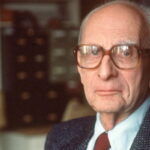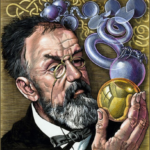We explain what structuralism is, what its characteristics and examples are. Also, what are its bases and post-structuralism.

What is structuralism?
Structuralism is a way of systematizing science and a method of cultural analysis which proposes the idea of structure as part of a whole. It also assumes that the different elements that make up culture can be understood as structures or parts of a general system. In this system, the elements that compose it relate to each other through the production of different meanings.
As a method and way of approaching a theory, structuralism is not a current in itself, but rather a shared way of doing science. It is used in philosophy, linguistics, anthropology, economics and psychology, among other disciplines. Structuralist analysis assumes that the various objects of research may contain hidden or underlying structures that are interrelated and that have significance because they are part of the same system.
See also: Relativism
History of structuralism
Saussure and the origins of structuralism
Structuralism emerged with the work of the Swiss linguist Ferdinand de Saussure, General linguistics course. This work was published in 1916 by Saussure's students as a compilation of the linguist's contributions during his years as a teacher.
Linguistics considers language as a system of signs and meaning that are related in an arbitrary and unnatural way. However, this system can be understood by a group of people who share certain conventions or norms.
For Saussure, language elements are understandable only among themselves and within the system that contains them. In this way, language goes beyond communication since it influences the individual and their role in society.
As a philosophical system, Saussure's linguistics seeks to analyze the systematic and constant relationships that exist in human behavior. These relationships give rise to the structures of a system of meaning.
Heyday and development of structuralism
structuralism acquired importance after the contributions of multiple disciplines and thinkers. The anthropology of Claude Lévi-Strauss, the psychoanalysis of Jacques Lacan, the semiotics of Roland Barthes, the epistemology of Michel Foucault and the Marxist philosophy of Louis Althusser are just a few examples.
After the Second World War, Western philosophical thought had existentialism as its leading voice. Philosophers such as Jean-Paul Sartre had acquired visibility and recognition both in philosophy and outside of it. However, thanks to the work of linguist Roman Jakobson, structuralism advanced into other fields of thought.
Jakobson's influence on the work of Lévi-Strauss was decisive in giving its own character to the French structuralist movement. Philosophers such as Roland Barthes and Jacques Derrida (even though Derrida did not recognize himself as a structuralist) brought the structuralist method to literature and literary analysis.
It is necessary to clarify that not all so-called structuralist thinkers recognize themselves as such. In addition to Derrida, Althusser and Foucault also reject the classification of their thought as structuralist.. To this day it is assumed that the only one who made a total reflection framed within structuralism is the anthropologist Lévi-Strauss.
Characteristics of structuralism
The structuralist movement is characterized by:
- There is a structure beyond the individual.
- This structure conditions and forms the individual.
- There must be a recognition of the structure itself.
- Once recognized, the structure obeys its own rules and laws.
Examples of structuralism
Some examples of structuralist analyzes are:
- The language. Analyzed by Ferdinand de Saussure from linguistics.
- The society. Analyzed by Claude Lévi-Strauss from anthropology.
- The economy. Analyzed by Louis Althusser from Marxist philosophy.
- The knowledge. Analyzed by Michel Foucault from epistemology and its relationship with power.
- The unconscious. Analyzed by Jacques Lacan from psychoanalysis.
The bases of structuralism
Structuralism turned out to be a kind of awakened consciousness that allowed us to understand and analyze the knowledge adopted unconsciouslyunder the customs and codes that take place in a specific culture and in which multiple disciplines of study intervene.
The structuralist current can be analyzed from three main bases:
- Linguistic structuralism. It is based on the theories of Saussure, considered the founder of linguistics. Linguistics is the discipline whose object of study is language, a system of signs that is found in the minds of several individuals and, therefore, is considered social and homogeneous. On the other hand, speech is an individual and heterogeneous action that interacts with language.
Saussure maintained that words are symbols that give meaning in reference to other words, but not to the nature of reality. The phonetics of a word or its acoustic image, what he called signifier, is arbitrarily related to the concept it represented, what he called meaning. People manage to understand each other when speaking because the relationship between signifier and meaning is based on social conventions or structures, that is, because they share the same codes. - Anthropological structuralism. It is based on the theories of Lévi-Strauss, who was a pioneer in considering anthropology from structuralism to analyze human beings and their life in society. That is, he managed to distance anthropology from the concept of history to achieve a more complex analysis.
Structuralism applied to anthropology made it possible to detect the underlying structure, or that remained hidden, and the various relationships between the underlying elements of that structure, such as systems of ideas, kinship or myths, to which individuals ended up subordinated. - Marxist structuralism. It is based on the theories of Louis Althusser, Nicos Poulantzas and Maurice Godelier, the main contributors to structural Marxism, who tried to establish that it was not Saussure who was the founder of structuralism, but Karl Marx.
Marx determined that structure should not be confused with visible relationships. His explanation of hidden logic established the foundations of structuralism. This turned out to be a common point among the different thinkers of structuralism, be they linguists, anthropologists or Marxists: they all considered the existence of a hidden or underlying structure in the object of study of each discipline.
Representatives of structuralism
Saussure
Ferdinand de Saussure (1857-1913) is considered the father of structuralism. His work in linguistics and semiotics had an impact not only on his areas of interest but also on other disciplines. His work General linguistics course It began the structuralist movement when it was taken up by different French and German thinkers in the mid-20th century.
Levi-Strauss
Claude Lévi-Strauss (1908-2009) is one of the great figures of 20th century anthropology. He was the founder of structural anthropology, which based its method on Saussurian linguistics. His work Structural anthropologyfrom 1958, exposes his theory.
Lacan
Jacques Marie Émile Lacan (1901-1981) is one of the most important figures in psychoanalysis. His return to Freud's works revitalized and redefined all the work done and the contemporary way of doing psychoanalysis. Despite being considered a post-structuralist, much of his work can be located within structuralism, especially his early works.
Althusser
Louis Althusser (1918-1990) is frequently associated with philosophical Marxism and social theory. However, his work incorporated many of the maxims of structuralism: Althusser reviewed this movement and incorporated structuralism into Marxist analysis in a critical and revisionist manner.
Poststructuralism
post-structuralism emerged from the 1960s as a critique of structuralist thought. Common themes among the various poststructuralist authors are the rejection of the self-sufficiency of structuralism and the questioning of the binary oppositions that constitute structures.
The starting point was taken from the 1966 speech given by French philosopher Jacques Derrida at Johns Hopkins University. Derrida questioned epistemological schemes that were based on dualisms such as man/woman or spirit/matter, which limited the apprehension of other points of view or that only considered one central concept and another peripheral.
Also questioned the stability and existence of thought structureswith the purpose of reaching new approaches previously marginalized by the methodology itself.
post-structuralism broke with the dualistic concept of structuralism who considered, for example, nature and society as opposite or binary terms. The main achievement of post-structuralism was to have rediscovered and expanded the analytical and radical possibilities of Saussure's theory of language (taken as the most representative significant phenomenon).
The main authors who are considered poststructuralists are Jacques Derrida, Roland Barthes, Michel Foucault, Gilles Deleuze, Jean Baudrillard, Julia Kristeva and Judith Butler, among others.

References
- Wahl, F., & Pirk, A. (1975). What is structuralism? Philosophy. Losada.
- T. Todorov, What is structuralism? Poetics. Losada.
- Piaget, J. (1971). structuralism. Proteus Publishing.
- Lévi-Strauss, C. (1958). Structural Anthropologie. Librairie Plon.
- “Structuralism” in Science Direct.
- “Structuralism” in Poetry foundation.
- “Poststructuralism as a point of intersection between environment and society” in Scielo.





